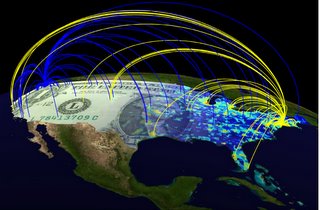His information came from a good post on the Science Blog. This in turn was apparently triggered by an article in Nature magazine. And I traced the source back to "Trace the Money", a press release from the Kavli Institute for Theoretical Physics at the University of California, Santa Barbara. This in turn leads to an earlier Nature article, "The scaling laws of human travel" by D. Brockmann, L. Hufnagel & T. Geise.

So what is this all about?
Where's George is a website that allows the user to enter the serial number of a piece of U.S. currency and a zip code, and find out whether that bill has ever been entered into Where's George before, and if so, the related geographic locations. Since people enjoy seeing where their money has been, a lot of people have entered information about these bills. The result is a database with a half million data points, each describing the travel of a single bill.
Brockmann, Hufnagel and Geise analysed this data base. They discovered that the distance traveled by the bills per unit time could be described by a statistical distribution with very simple parameters. The distribution was such that there was a significant chance of bills moving very long distances in relatively short periods of time.
Now, bills in circulation don't move from place to place by themselves; they move in peoples pockets. Consequently, one can infer that the distribution of movement of people is similar to that of the bills they carry. It would be very expensive to do a specific study to determine the distribution of geographic movement of a large population, but using the data from Where's George as a surrogate, the authors of the study were able to infer the properties of that distribution of the movement of people.
The authors have made a further inference. People carry germs, and specifically they sometimes carry a flu virus. If we have a pandemic flu, people will carry the disease virus. The distribution that describes the movement of money should also describe the movement of the flu virus, at least in the early stages before people change their travel patterns in response to the disease or the threat of disease.
If we hope to prevent a pandemic, public health officials would love to contain outbreaks of the disease to the local area in which they occur. The difficulty of doing so depends on how much people travel. This statistical work based on the movement of money then provides important input to the understanding as to whether containment will work.
Unfortunately, the information seems to suggest that there is a significant probability that someone from a small area will make a long journey before quarantine would be likely to be effective. If we see lots of outbreaks of a highly contagious, highly lethal flu, it will be very hard to contain and there may be a pandemic.
But this appears to be a nice piece of statistical analysis, and one that lead to an unexpected and interesting result. The authors are to be congratulated on recognizing an unexpected source of data that sheds light on what may be a critically important phenomenon.
No comments:
Post a Comment